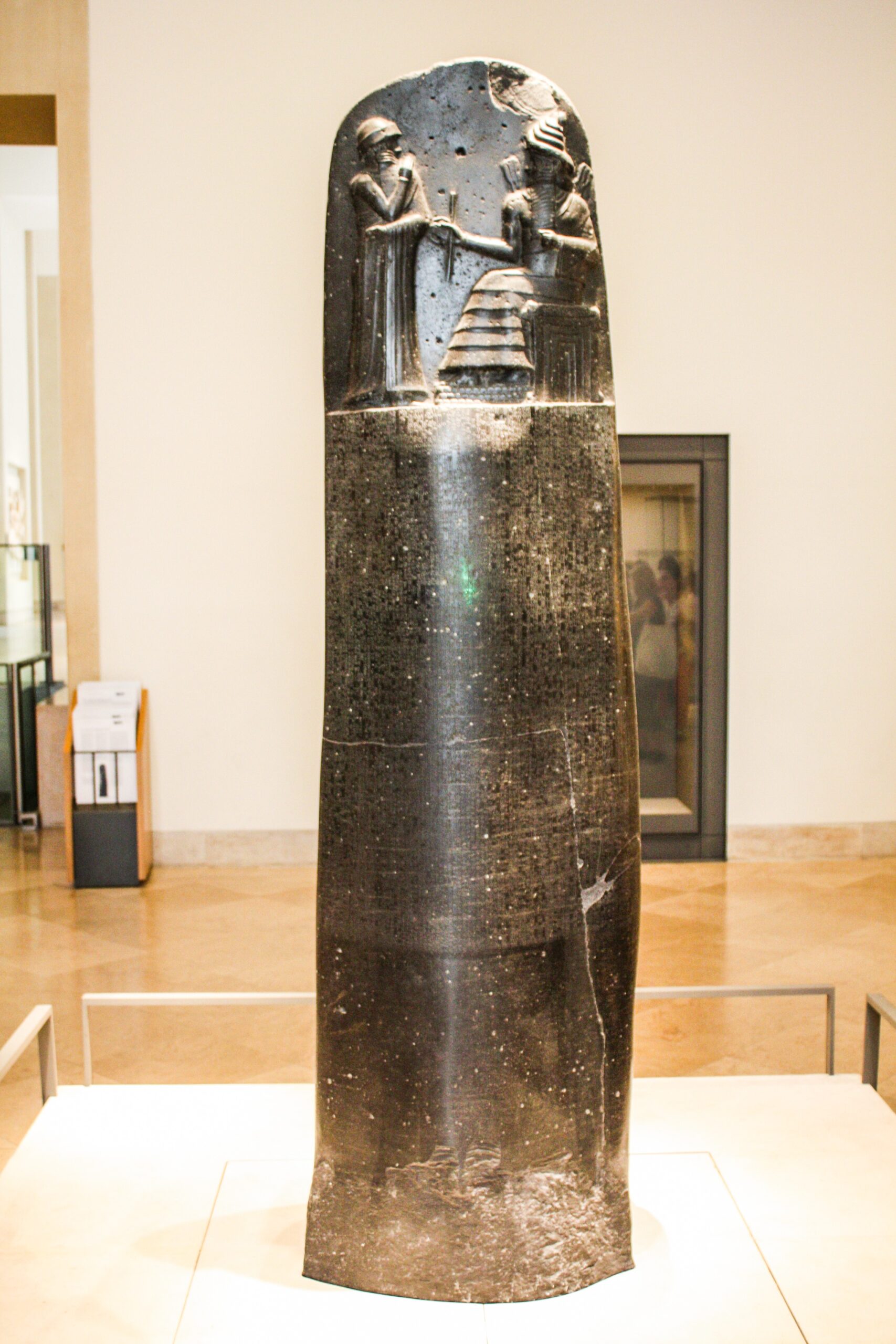Photo credit: Greg Emmerich. Flickr, CC BY-SA 2.0.
Hammurabi’s Code
By Julia Olson
Assistant Editor
Most of us know about King Hammurabi and his famous law code. The Babylonian king gave us the phrase “an eye for an eye,” which Ghandi famously reworded to add “and the whole world goes blind.”
If the phrase “an eye for an eye” does not sound familiar to you from the Code of Hammurabi, it should certainly ring a bell as part of the Covenant Code from the book of Exodus. So what gives? Was this a common ancient phrase? Or do we have a case of one ancient author borrowing an idea from another?
In order to understand the relationship between the Code of Hammurabi and the Hebrew Bible, we first need to know a little bit more about the famous Babylonian king after whom the Code is named.
Hammurabi ruled from about 1790-1750 B.C.E., during what we now call the Old Babylonian Empire. We are likely more familiar with the Neo-Babylonian Empire, as their king, Nebuchadnezzar, is notorious for the destruction of the Jerusalem temple in 597 B.C.E. But the Babylonian empire was around for a long time before Nebuchadnezzar. Its kings had a major impact on the political and social landscape of the ancient Middle East for many years.
While we may think that ancient kings focused primarily on warfare and expansion of their territory, kings like Hammurabi also focused on establishing their legacies through building projects and writing endeavors as well.
Ancient letters to and from the battlefield indicate that Hammurabi did engage in quite a bit of warfare, eventually incorporating several independent city states into the Babylonian Empire. But he would work extremely hard to ensure that his name was not associated with territorial expansion but with justice. He would achieve this association by commissioning the creation of his famous code.
The Code was first found on a six foot tall stele, or stone pillar, carved from basalt, in Susa (modern Iran).
Now, if you are familiar with geography and ancient kingdoms, you might be scratching your head. How did the stele of a Babylonian king who ruled in Iraq end up all the way down in Iran?
It turns out that ancient kings loved looting cultural heritage sites just as much as modern bandits do today. Shutruk-Nakhunte, an Elamite king who ruled from about 1185-1155 B.C.E. attacked Babylon and captured Hammurabi’s stele. By that time, the stele was about 600 years old, so it would have been a valuable display piece in Shutruk-Nakhunte’s palace. In fact, Shutruk-Nakhunte was a bit notorious for looting artwork from other kingdoms, sometimes even adding his own inscription to them to document his collection of the piece. He was one of the first ancient art collectors.
In 1901, a French expedition digging in Susa was rather surprised to find the stele from an Old Babylonian king so far away from its place of origin.
Eventually, the stele was translated, revealing that it was a law code given to the people of Babylon by the famous king Hammurabi.
The stele is topped with an image of the god Shamash, seated on a throne, handing a scepter to Hammurabi, who is standing before him.
The stele bears not only 282 laws, but a prologue and an epilogue as well.
In the prologue, Hammurabi describes how he was ordained by the gods to “bring about the rule of righteousness in the land” and to “further the well-being of mankind.”
The 282 laws cover everything from violent crime to fraud to family law and most things in between.
For the purposes of this exploration, we will only consider an excerpt of the Code.
Here are laws 195-212:
195. If a son strike his father, his hands shall be hewn off.
196. If a man put out the eye of another man, his eye shall be put out. [An eye for an eye]
197. If he break another man’s bone, his bone shall be broken.
198. If he put out the eye of a freed man, or break the bone of a freed man, he shall pay one gold mina.
199. If he put out the eye of a man’s slave, or break the bone of a man’s slave, he shall pay one-half of its value.
200. If a man knock out the teeth of his equal, his teeth shall be knocked out. [A tooth for a tooth]
201. If he knock out the teeth of a freed man, he shall pay one-third of a gold mina.
202. If any one strike the body of a man higher in rank than he, he shall receive sixty blows with an ox-whip in public.
203. If a free-born man strike the body of another free-born man or equal rank, he shall pay one gold mina.
204. If a freed man strike the body of another freed man, he shall pay ten shekels in money.
205. If the slave of a freed man strike the body of a freed man, his ear shall be cut off.
206. If during a quarrel one man strike another and wound him, then he shall swear, “I did not injure him wittingly,” and pay the physicians.
207. If the man die of his wound, he shall swear similarly, and if he (the deceased) was a free-born man, he shall pay half a mina in money.
208. If he was a freed man, he shall pay one-third of a mina.
209. If a man strike a free-born woman so that she lose her unborn child, he shall pay ten shekels for her loss.
210. If the woman die, his daughter shall be put to death.
211. If a woman of the free class lose her child by a blow, he shall pay five shekels in money.
212. If this woman die, he shall pay half a mina.
A few explanatory notes — there was a class difference between free people and enslaved people. Causing bodily harm to an enslaved person usually meant a cash payment. A mina and a shekel were weight measurements that were used to determine payments in silver. Harming a free person resulted in a far harsher punishment, sometimes even including the death penalty.
But let’s summarize this section briefly and then turn to a similar selection in the Hebrew Bible’s Covenant Code (Exodus 21). Law 195 tells us the punishment for striking one’s parent. The next chunk of laws give us our famous “eye for an eye, tooth for a tooth” statement. These laws address what happens when violence is committed between two people of equal status.
Laws 202-208 deal with injuries committed between parties of different social statuses.
Finally, Laws 209-212 discuss what happens if two men fight near a pregnant woman and somehow their altercation causes her to lose her child. This is an oddly specific hypothetical situation that is addressed in the Code.
Let us now consider a selection of the Covenant Code from Exodus 21.
In Exodus 21:22-25, the law states “When people who are fighting injure a pregnant woman so that there is a miscarriage, and yet no further harm follows, the one responsible shall be fined what the woman’s husband demands, paying as much as the judges determine. If any harm follows, then you shall give life for life, eye for eye, tooth for tooth, hand for hand, foot for foot, burn for burn, wound for wound, stripe for stripe.”
It should not escape our notice that the extremely specific hypothetical situation regarding the pregnant woman from the Code is echoed here in Exodus. Not only that, but it is accompanied by the Code’s famous line about an eye for an eye. The Hebrew Bible expands the phrase a bit, but the proximity between the highly specific law and the phrase itself should call our attention to something rather interesting happening with our biblical authors.
Just before this law in the Covenant Code we are given some other laws that ought to sound familiar.
In 21:15 we are told “whoever strikes a father or mother shall be put to death.”
In 21:18-19, we find that “When individuals quarrel and one strikes the other with a stone or fist so that the injured party, though not dead, is confined to bed, but recovers and walks around outside with the help of a staff, then the assailant shall be free of liability, except to pay for the loss of time, and to arrange for full recovery.”
In 21:26-27 we are given a case regarding violence between people of different statuses: “When a slave-owner strikes the eye of a male or female slave, destroying it, the owner shall let the slave go, a free person, to compensate for the eye. If the owner knocks out a tooth of a male or female slave, the slave shall be let go, a free person, to compensate for the tooth.”
Are these starting to sound familiar? In very close proximity in both the Code of Hammurabi and the book of Exodus, we are given laws about treatment of one’s parents, altercations between people of similar or different social statuses and laws about what happens if a quarrel causes a pregnant woman to lose her child.
Let me restate this. Laws 195-212 of the Code of Hammurabi and Exodus 21:15-27 cover essentially the same legal cases in almost the same order. Further, they both include the famed “eye for and eye” concept. Yet, the Code of Hammurabi dates to over 1000 years before the finalized version of the book of Exodus! Did the biblical authors use the Code of Hammurabi as a crib sheet for their own laws?
Of course not. Our biblical authors are rather ingenious, and they’re doing something very specific by borrowing this material from the Code of Hammurabi.
In order to see what they are doing, we need to consider how they might have encountered the Code in the first place.
While the Code that was uncovered in Susa was as much a monument as it was a set of laws, it also provided a template for scribal practice. The Code of Hammurabi was most likely copied on smaller clay tablets by scribes from all over the region. It would have been circulated not only by Hammurabi as a means to further his impact but also by scribes, who would have used the Code to train new scribes and practice their cuneiform writing. So there’s a definite chance that Israelite scribes would have seen copies of the Code. But let us not forget that the Israelites spent some time in Babylon themselves. Scribes, artisans, priests and other intellectual elites would have been the first to be deported after Nebuchadnezzar’s attack on the temple. Even though Shutruk-Nakhunte would have already taken the large basalt stele discussed at the opening of this article back to his palace in Susa, copies of Hammurabi’s Code on clay tablets would have remained in Babylonian scribal repositories. This means that, during exile, Israelite scribes in Babylon would have certainly had exposure to the Code, if they had not already seen copies circulating throughout the Eastern Mediterranean region before that time.
But the Israelite scribes did not copy the laws from Hammurabi’s Code wholesale. Instead, they used the idea of a law code to subvert Babylonian religious ideas and concretize their unique belief in their own deity. It is Hammurabi who receives the Code from the god Shamash and who is responsible for upholding justice in the land. The king is the ultimate deliverer of law, order and peace. But who receives the laws of the Covenant Code or, for that matter, the entire Pentateuch? Not a king, but a prophet. Hammurabi’s Code was a king’s statement about his achievements. But, for the biblical authors, the material became a contract between God and Israel, delivered not by a king but by a humble prophet. Instead of a statement about a king’s power, the biblical authors used the language of the Code to make a statement about how to maintain an ongoing relationship with God.
This means that when the laws of the Covenant Code mirror those of Hammurabi’s, as illustrated above, the biblical authors are not copying Hammurabi’s ideas. Instead, they are using what would have been for their audience extremely familiar language to show how different their relationship with justice and the deity is than that of the Babylonians. Imagine the audacity of creating such a document perhaps while under the control of the very leadership you are criticizing! The biblical authors are doing something very radical. In modern terms, it’s a bit like sampling someone’s own music to make a diss track about that person. It’s using Babylonian state propaganda material to undermine the Babylonian state. This is amazing ideological footwork!
When we read the Covenant Code in the book of Exodus, or the rest of the laws in the Pentateuch, we should be in awe not only that the Israelite scribes saw justice as the foundation for their relationship with God, but that they occasionally used the language of their very oppressors to make the case that the relationship was special.
Sources:
Hammurabi’s Code, translated by L. W. King, 1910





